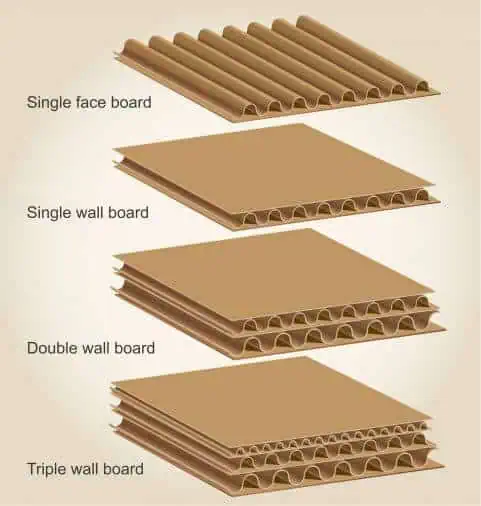The different types of cardboard packaging
There are many different types of cardboard on the market. Thus, cardboard is a very versatile material with different thicknesses, shapes, and forms. The most common use for cardboard is in packaging and shipment.
This guide presents information on the different types of cardboard packaging. Let’s start by looking at what exactly corrugated cardboard is and what it is made out of, including what they’re typically used for.
Shredded cardboard packaging material
Are you looking for more information on different types of cardboard packaging material? Check out our guide about types of shredded cardboard.
What is corrugated cardboard
Corrugated cardboard, also known as corrugated fiberboard, is a typically cardboard for packaging situations such as moving house or packaging products. It is made of kraft paper and can be re-used.
Watch this YouTube video to see the step-by-step process of how corrugated boxes are made.
What kind of cardboard is used for packaging?
We have listed below several different kinds of cardboard packaging, depending on your needs and requirements:
Navigation:
Corrugated fiberboard
Corrugated fiberboard is the most common type of cardboard and is characterized by its flute profiles. It is made from three different elements:
A wavy, fluted corrugation layer between two other flat layers of cardboard. This type of packaging is used for shipping goods and has quite a high-strength-to-weight ratio, depending on the level of protection you required.
![]()
Also, corrugated fiberboard sizes are commonly represented by letters of A, B, C, E or F. The width and frequency of the waves in the fluted layer in the middle determine the size.
- “A flute” – 1/4″ = commonly used for fragile products.
- “B flute” – 1/8″ = used for padding.
- “C flute” – 11/64″ = optimal for shipping boxes and to secure heavier items.
- “E flute” – 1/16″ = used in displays and retail packaging.
- “F flute” – 1/32″ = can be found in shoeboxes and clamshell packaging.
Single-face board
![]()
Single-face-board looks like corrugated fiberboard, except it doesn’t have the second section on the other side of the flute layers. This type of packing is often used to segregate items in a single box so that they don’t get broken during transit.
Single-wall board
![]()
This type of packing is a typical corrugated cardboard and features paperboard on both sides of the fluting to guarantee protection against impact that aren’t too delicate. Single-wall board is commonly used in boxes.
Double-wall board
![]()
The double-wall board adds an extra layer of fluting in between the two outermost layers. This type of packing offers extra protection for whatever goods are stored inside and are more resistant to bending.
Triple-wall board
The triple-wall board are very strong boxes and is ideal for heavy objects like automotive parts or major appliances. This cardboard contains 3 layers of fluting in between the two outside walls.
![]()
But there are even more cardboard with more layers, such as four, five, or more layers of fluting between the two outside walls. Thus, these more-walls are very uncommon and would only be used in rare instances.
Honeycomb cardboard
![]()
Honeycomb cardboard is a less commonly used type of cardboard packing. It consists of several layers of corrugation, which make up the length of the piece. This type of packing material helps to fill empty spaces for the packaging or transportation of any type of product.
Paperboard
![]()
Paperboard is an extremely thin form of cardboard that is utilized for toilet paper rolls and cereal boxes. Thus, it is also known by the name chipboard or carton and is less durable than corrugated fiberboard. Also, paperboard is used for lighter items or non-load-bearing applications.
Grey paperboard and grey cardboard
![]()
Both types are made of recycled paper materials. Grey paperboard is used for packaging purposes and grey cardboard can be found in different industries, including bookbinding and packaging products. The difference between these two is the thickness.
Matboard
![]()
Matboard is a heavy paper-based material and can be found in picture frames to protect artwork or photography. It comes in several different types of matboard such as a standard matboard, black core, white core and color core matboard, and conservation board.
What is the difference between corrugated and cardboard?
The main difference between corrugated cardboard and the non-corrugated cardboard is the structure. Corrugated fiberboard is normally made up of more layers rather than just a single sheet.
Other differences:
- The added layers keep your goods safe throughout the entire shipping process.
- Corrugated cardboard is more eco-friendly than non-corrugated cardboard
- Corrugated cardboard is customizable and is available in different size, card thickness and color.

Read here the 10 advantages of corrugated board that the German association of Corrugated Board Makers has summarized.
Is corrugated cardboard recyclable?
Short answer: Yes, most of the corrugated cardboard. We say most because it also depends on the condition and if there are chemical substances.
The Packaging Company shared their knowledge when it comes to recyclability of corrugated cardboard in different situations.
Which industry uses most corrugated boxes?
As we know, corrugated cardboards are popular and are used as packaging material. With that being said, these industries are using corrugated fiberboards:
- Office Supply
- Industrial supply and logistics
- E-commerce
- Relocation
More detail can be read here.
Cardboard recycling advice
What can your business do to improve the reduction, reuse, and recycling of cardboard? Read our Cardboard Recycling Guide.
Recycling solutions for warehouses
By Recycling.com/ 24 November 2022